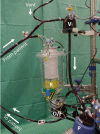Minimized extracorporeal circulation in non-coronary surgery
- PMID: 31293800
- PMCID: PMC6586581
- DOI: 10.21037/jtd.2019.02.04
Minimized extracorporeal circulation in non-coronary surgery
Abstract
Minimally invasive extracorporeal circulation (MiECC) technology is characterized by improved biocompatibility due to closed-loop design, minimized priming, and markedly reduced artificial surface. Despite well-evidenced clinical advantages in coronary surgery, MiECC penetration in complex open-heart surgery is low. Concerns have been raised by surgeons and perfusionist regarding safety of perfusion in situations when the heart is opened and air is entering the closed system. Moreover, issues of blood and volume management are deemed impractical without having a reservoir. In the evolution of MiECC safety aspects as well as means of air and volume management have been addressed. The integration of active air removal devices, and the possibility of venting and volume buffering made MiECC suitable for valvular or even more complex surgery. However, typical clinical benefits found with MiECC in coronary artery bypass grafting (CABG) surgery, in particular blood sparing effects, were not reproducible. Air handling and blood management remain the main issues of MiECC in non-coronary surgery. With the introduction of modular (type IV) MiECC systems containing a second, accessory circuit for immediate conversion to open cardiopulmonary bypass (CPB), the last obstacles seem to be cleared away. The first reports using this latest development in MiECC technology sound promising. It is now up to the cardiac surgical community to adopt this technology and produce data helping to answer the question whether MiECC is the best perfusion strategy for all comer's cardiac surgery.
Keywords: Minimally invasive; extracorporeal circulation; heart surgery.
Conflict of interest statement
Conflicts of Interest: The authors have no conflicts of interest to declare.
Figures

References
-
- Gibbon JH. Application of a mechanical heart and lung apparatus to cardiac surgery. Minn Med 1954;37:171-85. - PubMed
Publication types
LinkOut - more resources
Full Text Sources
